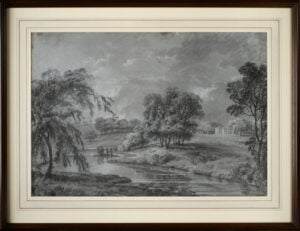Barrett, George Sr. (b.1728-32 – d.1784)
One of the most renowned Irish landscape artists of the 18th century, George Barret (Senior) succeeded in carving out a highly lucrative career as a painter in London, before succumbing to bankruptcy. All four of his children became artists, including George Barrett Junior (1767-1842). Barret occupies an important position of one of the forerunners of romantic landscape.
Born in Dublin, the son of a clothier, he was initially apprenticed to a corset-maker before studying drawing and painting under Robert West at the Royal Dublin Society School in George's Lane. At the age of 15 he drew attention to himself by winning a prize at the annual examination of the Dublin Society. While at art school, he earned money by colouring prints for a print-seller in Nicholas Street and after graduating he worked for a time as an art teacher in a Dublin school.
It was during his early twenties that Barret was noticed by Edmund Burke, who later became one of his patrons. Meantime, Burke persuaded Barret to visit and paint in County Wicklow, where he spent several years depicting the Powerscourt waterfall. In 1757, he married Frances Percy, a Dublin girl. In 1763, at the age of 30, due to lack of interest in his landscape painting and specifically because he could find no buyer for a series of etchings, he left Dublin to seek his fortune in London. The following year he duly sent a number of pictures to the exhibition of the Society of Artists, including View of the Waterfall at Powerscourt, and View in the Dargle. Some months later, his large-scale composition Landscape with Figures was shown at the Free Society Exhibition where it gained a prize of £50 given by the Society of Arts for the most accomplished landscape.
Befriended and recommended by fellow Irishman James Barry, who had just mourned the death of the Cork landscape painter John Butts, Barrett continued to exhibit at the Society of Artists for the next three years until 1768, and less regularly with the Free Society. His talent for creating idyllic Claudian-type pastoral views and romantic mountainous landscapes soon attracted a number of patrons, and commissions poured in. It is said that Lord Dalkeith paid £1500 for three of his paintings, almost certainly a wild exaggeration, although even half this amount was a huge sum at the time. Barret was also heavily involved in the foundation of the London Royal Academy, becoming one of it's original members, and showed there regularly until 1782 – a total of 31 paintings in all. By now, he was earning the princely sum of £2,000 a year, but unfortunately spending even more. Mercifully, his old friend Edmund Burke rescued him from the consequences of bankruptcy by se-curing him the lucrative position of Master Painter to Chelsea Hospital. For the last two years, although suffering from asthma and general ill-health, Barret continued to paint, producing some of his best work. He died in 1784, aged 52.
Inspired by Dutch Realists such as Jacob van Ruisdael (1628-82) and Jan Wijnants (1620-84), George Barret showed a great talent for both composition and painterly dexterity, although some critics now think that he overplayed his sense of formality. For example, while his scenery was both topographically correct and botanically accurate, it was less inspirational than some of his contemporaries. That said, his portrayal of water, his tonal work and his depiction of foliage was and still is highly regarded.
Although Barrett specialized in oil painting, he also produced a number of works in gouache and watercolour, along with a few etchings.
George Barret's works appear in a number of public and private collections including: National Gallery of Ireland, Limerick Art Gallery, Victoria and Albert Museum, London and the Walker Art Gallery, Liverpool, to name but a few.
Showing the single result
